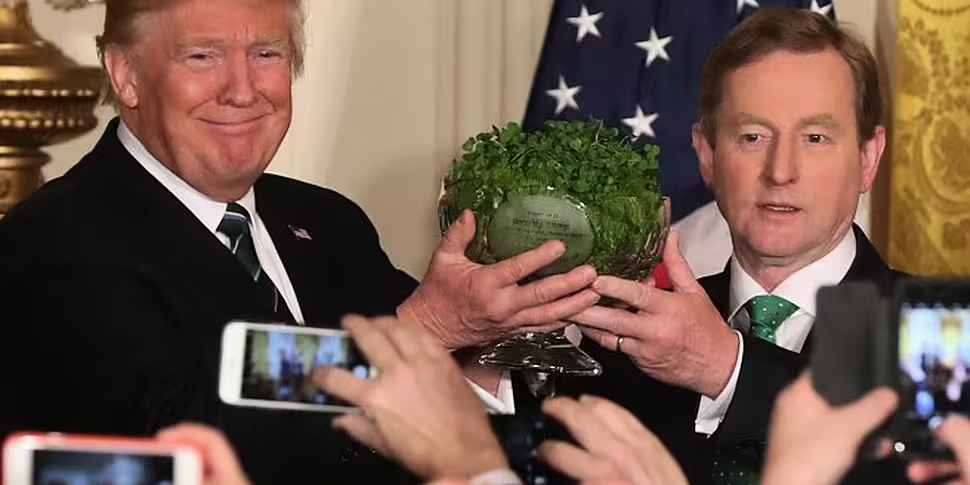In his inaugural address on January 20th, Donald Trump pledged that what he would end what he described as 'American carnage'.
The subsequent 11 months, however, could be best described as ‘American chaos’ - and that’s at least partially seems to be the new US leader's intention.
***
It’s hard to believe that it’s barely a year since the billionaire and reality TV star achieved a shock victory over Hillary Clinton in the 2016 US presidential election. The months since President Trump entered the Oval Office have been an unprecedented whirlwind of controversies, drama, outrages, twists, turns and tweets. POTUS 45 has displayed an often jaw-dropping willingness to deviate from conventional rules & etiquette, and his leadership approach has been as divisive & unpredictable as his campaign.
As 2017 draws to a close - still almost a month from the first anniversary of Trump’s inauguration - the sheer volume of stories makes it feel like it has been several years’ worth of news compressed into a mere 11 months. Something like the US president’s travel ban issued against several predominantly Muslim countries seem like a relatively distant memory - even if the story has been continuing on in the background, to comparatively limited fanfare.
It’s certainly worth recalling some of the earliest developments from Trump’s presidency, even if listing & detailing them all would be a futile exercise (and inflate this article’s word count dramatically). He announced his decision to withdraw from the Trans-Pacific Partnership; he nominated Neil Gorsuch to the Supreme Court, after Republicans had refused to begin hearings for Barack Obama’s nominee; he loosened the regulations put in place after the financial crisis; he installed a climate change sceptic to run the Environmental Protection Agency; he falsely accused Obama of ‘wire-tapping’ Trump Tower.
That, and much more, was by early March.

President Donald Trump speaks while aboard the nuclear aircraft carrier Gerald R. Ford, Thursday, March 2, 2017. Picture by: Pablo Martinez Monsivais/AP/Press Association Images
The last example is a good example of one of the most significant features of the Trump presidency - the role has in no way tempered the US president’s infamous tweeting habits. In his time in the Oval Office, he has continued to start feuds and reignite older ones - social media storms ranging from petty personal grudges to potentially catastrophic international disputes. His attacks against the media have, if anything, only intensified - the tweets about ‘fake news’ (which, in Trump’s broad interpretation, appears to refer to everything from legitimately inaccurate stories to verifiably true stories he just happens to dislike) are an almost daily occurrence.
There’s been no shortage of eyebrows raised when it comes to his sharing of unusual, questionable or straight-up outrageous content - the US president retweeting messages from conspiracy theorists or far-right anti-Muslim groups is something most people will never get used to.
The Britain First retweets drew much international criticism, including a rebuke from Theresa May. True to his ‘America first’ rhetoric, Trump’s approach to relations with the rest of the world could politely be described as bullish.
His aggressive approach towards North Korea could justify an article of its own, but there’s been far more drama on the wider international stage. His actions have, after all, frequently flown in the face of international consensus. His decisions to withdraw from the Paris climate deal and declare Jerusalem the capital of Israel are perhaps the most high-profile examples - two actions that were almost universally condemned by the international community. His insistence on building ‘the wall’ between Mexico and the US has notably worsened relations between the US and one of its two neighbours.
At the same time, Trump’s various foreign trips to Asia & Europe have gone off reasonably smoothly (at least publicly). He certainly has been more cautious in his approach to the likes of China when compared to his provocative campaign promises. Despite his frequent criticisms of Irish tax laws, Trump's first meeting with an Irish leader - then Taoiseach Enda Kenny - was an amiable affair, although Mr Kenny managed to secure some international attention after 'lecturing Trump on immigration'. Still, despite plenty of photos of Trump with smiling world leaders, there’s still a strong argument to be made that the US’ status on the world stage has shifted rather dramatically in the last year.
Politically, Trump and his fellow Republicans had a relatively rough year - although, as 2017 wound down, managed to achieve at least one substantial success.
In terms of legislation, a pledge to repeal the so-called Obamacare health care legislation was the most significant priority for Republicans in both the White House and on Capitol Hill. However, it ultimately proved a humiliating defeat - despite years of pledges that they would repeal & replace Obama’s signature policy achievement, Republican leaders were unable to muster up the support from their own ranks despite controlling both houses of Congress.
After weeks of high-stakes political drama, it all boiled down to a ‘too close to call’ late-night vote on the Senate floor in late September. It was Republican Senator John McCain who sunk his party’s Obamacare repeal goal with his vote against the proposed measures. Trump remained defiant, but there was no doubt it was a massive blow for the president and his policy plans.
Can you believe that Mitch McConnell, who has screamed Repeal & Replace for 7 years, couldn't get it done. Must Repeal & Replace ObamaCare!
— Donald J. Trump (@realDonaldTrump) August 10, 2017
Their healthcare hopes dashed, Trump & his fellow Republicans instead doubled-down in their efforts to pass a major tax reform bill. The legislation itself was widely criticised for focusing on tax cuts for corporations and the rich, as well as for potentially adding trillions to the US national debt. Unsurprisingly, there was little public support for the measures. Nonetheless, both the House and Senate leaders managed to get the legislation through - as of writing, it seems likely that President Trump will sign & approve a massive change to US tax laws by Christmas.
The domestic & international drama has been echoed within the walls of the White House itself. One incredible (in hindsight, at least) group shot taken in the Oval Office early in Trump’s presidency - during a phonecall with Vladimir Putin - shows Vice President Mike Pence flanked by Reince Priebus, Steve Bannon, Sean Spicer and Michael Flynn.

Picture by: Pool/ABACA/ABACA/PA Images
By the end of August, only Pence was left - Flynn, in fact, was gone within weeks of that photo’s publication.
The staffing chaos was perhaps best captured by the absurdly short tenure of Anthony Scaramucci. ‘The Mooch’ managed to last a mere 10 days as White House director of communications before being fired - although that wasn’t an entirely surprising firing in the wake of his foul-mouthed tirade against several of his colleagues while speaking to a New Yorker reporter.
Even after months of high-profile resignations and firings, and as new Chief of Staff John Kelly apparently instilled some sense of order to proceedings, whispers of administration chaos haven’t quite died down. Indeed, speculation about Secretary of State Rex Tillerson’s potential departure has been particularly persistent.
And then there’s Russia. The Trump administration has been unable to shake off the revelations & speculation surrounding alleged Russian interference in the 2016 election. It has dominated much of the coverage of the Trump presidency, and seemingly resulted in extraordinary developments such as the firing of FBI chief James Comey.
The investigation led by special counsel Robert Mueller is still in its early stages, but has already seen charges brought against Trump’s former campaign manager Paul Manafort and former national security adviser Michael Flynn. It’s a story that has repeatedly provided a major headache to the administration, and Trump has repeatedly denied that there was any collusion. However, regardless of its eventual findings, it seems certain the Russia investigation will continue to dominate headlines for some time yet.

President-elect Donald Trump pumps his fist as he arrives during the 58th Presidential Inauguration at the U.S. Capitol in Washington | Image: Andrew Harnik AP/Press Association Images
Going back to his inaugural address, Donald Trump pledged to act for “all Americans”. But it’s no stretch to say his presidency to date has proven utterly divisive in a way without equal in modern times.
One major controversy not mentioned above is his reaction to the Charlottesville protests, where he made the instantly infamous declaration that “both sides” were to blame for the violence that broke out during a white nationalist protest. The strong reaction surrounding the incident and its fallout was symbolic of much of the deep, deep division that exists in the US in 2017. Trump himself has very much become a symbol of the division - and he’s secured both the fierce loyalty of his base and the impassioned ‘resistance’ of his opponents.
One of the dangers of a relentless assault of stories and fast-paced news cycles is that much noteworthy news is neglected or quickly forgotten amid the next development. In one week alone, for example, President Trump’s decision to retweet a number of anti-Muslim videos from a British far-right group was quickly eclipsed by the Michael Flynn guilty plea and the rush to pass the Republican tax bill. Major international stories - such as the plight of the Rohingya in Myanmar, or the continuing humanitarian crisis in Yemen - often feel like they get short shrift as the Trump show rolls on.
Indeed, it almost felt like the catastrophic hurricane damage in the US territory of Puerto Rico was most widely covered when President Trump briefly showed up to throw paper towels to residents. The story, despite still causing chaos on the island, has since faded into the background for many major media outlets.
Ultimately, there’s little reason to imagine 2018 will be any less dramatic when it comes to Trump. Robert Mueller’s Russia investigation moves ever-forward, its final destination still anyone’s guess. Tensions between North Korea and the US remain high. Trump continues to casually alienate old allies - any state visit to the UK, for example, is likely to be met with massive protests. No doubt he will find fresh ways to horrify his opponents and rally his base.
And then there’s the ever-present spectre of the 2018 midterm elections, when many US politicians will have to fight to retain their seats. Democrats will be fighting to gain control of Congress; Republicans will be desperately hoping to retain or improve their existing majorities; and, for Trump, it will be a large-scale test of how voters have responded to his presidency and indeed ‘Trumpism’ in general.
The drama has already begun. With only weeks to go before the New Year, Democrats managed to unexpectedly secure a Senate seat in a special election in the traditionally Republican state of Alabama. The high-profile result will see the GOP’s Senate majority decrease to a mere one seat, further limiting their room for error as they attempt to push through their legislative agenda. The pressure is very much on both parties now as they gear up for elections that could, yet again, radically change the political climate in Washington.
A major election. An ongoing investigation. A president who has continued to shock & surprise on an almost daily basis. Make sure you’re strapped in, because Trump’s year two is likely to be every bit the rollercoaster ride his year one has been...









